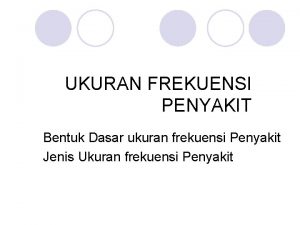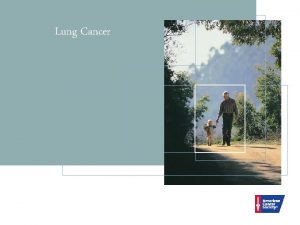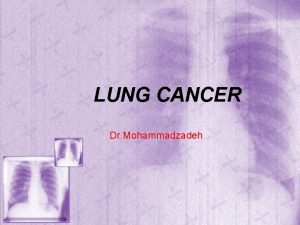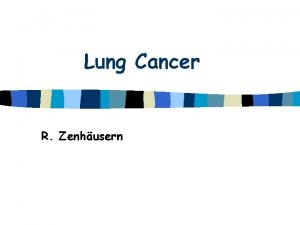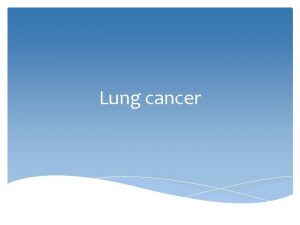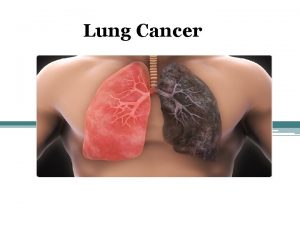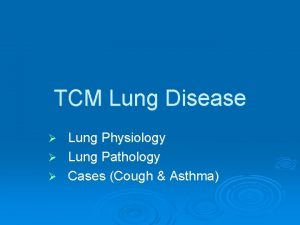Lung Cancer Lung Cancer Incidence n n n













- Slides: 13

Lung Cancer

Lung Cancer Incidence n n n n 1950 s Male/Female ratio 6: 1, this is now 7: 5. (decreasing male smoking rates, increasing female smoking rates). Approximately 23, 000 men and 15, 000 women diagnosed with disease per year 2 nd most common cancer in men (after prostate) 3 rd in women (after breast and bowel) UK: Between 1995 and 2004 , male lung cancer prevalence decreased by 23%. Same 10 year period so almost no change in female rates. Males and Females combined: a reduction of incidence rates of 16% 13% of all new cases of cancer are lung cancers

n n UK: 5 year survival (diagnosis during 1999 – 2003) was 6. 5% in men and 7. 6% in women. This is NOT significantly better than for patients diagnosed a decade or so earlier.

Causes of Lung Cancer n n SMOKING! Over 80% (Association for international Cancer Research) or 9 out of 10 (Cancer Research UK) are caused by smoking (passive included) Exposure to industrial carcinogens and air pollution, scarring from previous lung disease, family history and past cancer treatment. Length of time smoking – as soon as you stop your risk goes down Second hand smoke: double your risk

Symptoms n n n n n Difficulty breathing Coughing up blood Chest pain Loss of appetite Weight loss Fatigue Having a cough most of the time A change in a cough you have had for a long time Short of breath Ache or pain when breathing or coughing

Types of lung cancer n n Small Cell Lung Cancers (SCLC) Non-Small Cell Lung Cancers (NSCLC) –Squamous cell carcinoma, adenocarcinoma and – large cell carcinoma

Ethnicity n n n UK: South Asians have a lower incidence of lung cancer than non-South Asians but increasing incidence has been reported amongst South Asian men (in contrast to the rest of UK male population where incidence is declining) South Asian Women also have increasing lung cancer trends but this is in line with the rest of UK female population. USA: lung cancer rates in black population are higher for both males and females compared with white population.

Socio-Economic Status n n Incidence and Mortality rates – strongly associated with deprivation. 1993 England Wales: Incidence 2. 5 times higher in most deprived males compared to least deprived males – women difference was greater than 3 times. 2004 gap between most deprived and most affluent – 50% (down from 200% in 1981). Lung cancer incidence has increased in more affluent women than deprived women between 1981 and 2004

Age n n Risk increases with age. UK: 8 out of 10 cases occur in people aged 60+

Regional Differences n n n UK: clear north/south divide. High lung cancer rates in Scotland Northern England. Scottish men and women have among highest rates in world reflecting the country’s history of high smoking prevalence Incidence rates in Scotland particularly high in densely populated belt from Glasgow in the west to Edinburgh in the east. Higher rates in urban areas.

Around the World n n Highest rates of lung cancer in women – N. America and Northern Europe Highest rate of lung cancer in men – Europe, especially central and eastern Europe and N. America. In Europe – highest male rates are Hungary and Poland – Lowest in Sweden and Malta. Lowest incidence rates in men and women are found in African and Asian countries.

Data Sources n n n Easily accessible Regularly Updates Lots of info. On UK and World Easy to use without knowing fully how accurate/representative they are Differences in recording systems (especially important when comparing countries), may define key terms or key criteria differently affecting the results. Do we really know how data is collected and what its original purpose was?

Data Sources n n n http: //www. aicr. org. uk/lungcancerfaqs. stm? s ource=Adwords http: //www. statistics. gov. uk/cci/nugget. asp? i d=1657 http: //www. cancerhelp. org. uk/help/default. as p? page=2962 http: //info. cancerresearchuk. org/cancerstats/ types/lung/incidence/, http: //info. cancerresearchuk. org/cancerstats/ types/lung/
 Incidence density formula
Incidence density formula Prevalence vs incidence
Prevalence vs incidence Servier medical art
Servier medical art Optimal lung cancer pathway
Optimal lung cancer pathway Tnm stage lung cancer
Tnm stage lung cancer Lung cancer screening shared decision making tool
Lung cancer screening shared decision making tool Lifetime risk of lung cancer
Lifetime risk of lung cancer Siadh vs di
Siadh vs di Nursing process sequence
Nursing process sequence Central european lung cancer patient network
Central european lung cancer patient network Optimal lung cancer pathway
Optimal lung cancer pathway Cara hitung insiden rate
Cara hitung insiden rate Oriented incidence matrix
Oriented incidence matrix Owasp cloud top 10
Owasp cloud top 10











